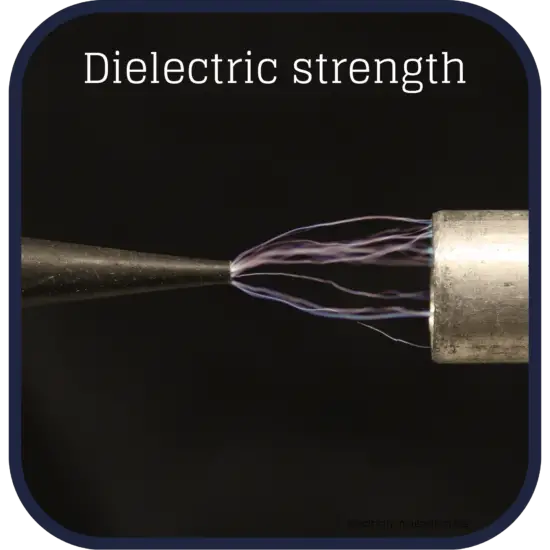30-second summary
Dielectric Strength
The dielectric strength of insulating material is defined as the highest electric field strength that it can tolerate intrinsically without losing its insulating characteristics.
In a sufficiently strong electric field, the insulating properties of an insulator break down, allowing the flow of charge.
Dielectric strength is measured as the maximum voltage required to produce a dielectric breakdown through a material.
The dielectric strength of dry air is about 3 MV/m.
It is important to note that the dielectric strength of a material can vary depending on factors such as temperature, humidity, and the presence of impurities or defects.
See also: Capacitance
See also: Electric polarisation
See also: Permittivity

Dielectric Strength
The dielectric strength of insulating material is defined as the highest electric field strength that it can tolerate intrinsically without losing its insulating characteristics. In a sufficiently strong electric field, the insulating properties of an insulator break down, allowing the flow of charge. Dielectric strength is measured as the maximum voltage required to produce a dielectric breakdown through a material.
In SI, the unit of dielectric strength is volts per meter (V/m). It is also common to see related units such as volts per centimeter (V/cm), megavolts per meter (MV/m), and so on.
This quantity is affected significantly by temperature, trace impurities, small irregularities in the metal electrodes, and other factors that are difficult to control. For this reason, we can give only approximate figures for dielectric strengths. The dielectric strength of dry air is about 3 MV/m. The table below shows the dielectric strengths of a few common insulating materials. Note that the values are all substantially greater than the value for air.
Dielectric strength is very important for dielectrics in capacitors. The introduction of a dielectric is also to limit the potential difference that can be applied between the plates to a certain value Vmax, called the breakdown potential. If this value is substantially exceeded, the dielectric material will break down and form a conducting path between the plates. A few such values are listed in the table below.
Dielectric strengths of the ten most important materials.
The following are the approximate dielectric strengths (in kilovolts per millimeter or kV/mm) of the 10 most important dielectrics:
- Air – 3 kV/mm
- Vacuum – 20-150 kV/mm (depending on the level of vacuum)
- Diamond – 1-2 MV/mm
- Glass – 0.01-1 MV/mm (depending on type and quality)
- Paper – 5-50 kV/mm (depending on thickness and quality)
- Mica – 10-200 kV/mm (depending on type and quality)
- Porcelain – 10-40 kV/mm
- Teflon – 60-120 kV/mm
- Polyethylene – 15-50 kV/mm (depending on density and quality)
- PVC (Polyvinyl Chloride) – 40-50 kV/mm
It is important to note that the dielectric strength of a material can vary depending on factors such as temperature, humidity, and the presence of impurities or defects. Additionally, the breakdown voltage can depend on the specific geometry and orientation of the material being tested. These values are provided as a rough guide and may not apply in all situations.
Dielectrics in Capacitors
Dielectrics have many applications, but the most significant use is in capacitors. In many capacitors, there is an insulating material such as paper or plastic between the plates. Such a material, called a dielectric, can be used to maintain a physical separation of the plates.
Placing a solid dielectric between the plates of a capacitor serves three functions.
- Mechanical separation
- Electrical isolation – higher voltage possible
- Electric field reduction – higher capacitance
First, it solves the mechanical problem of maintaining two large metal sheets at a very small separation without actual contact.
Second, using a dielectric increases the maximum possible potential difference between the capacitor plates. Any insulating material, when subjected to a sufficiently large electric field, experiences a partial ionization that permits conduction through it. This is called dielectric breakdown. Note that the dielectric strength of air is approximately 3 kV/mm. Many dielectric materials can tolerate stronger electric fields without breakdown than can air. Thus using a dielectric allows a capacitor to sustain a higher potential difference and so store greater amounts of charge and energy.

